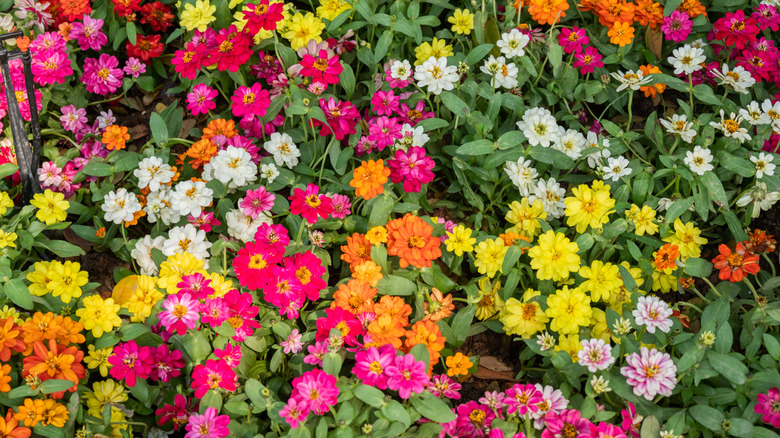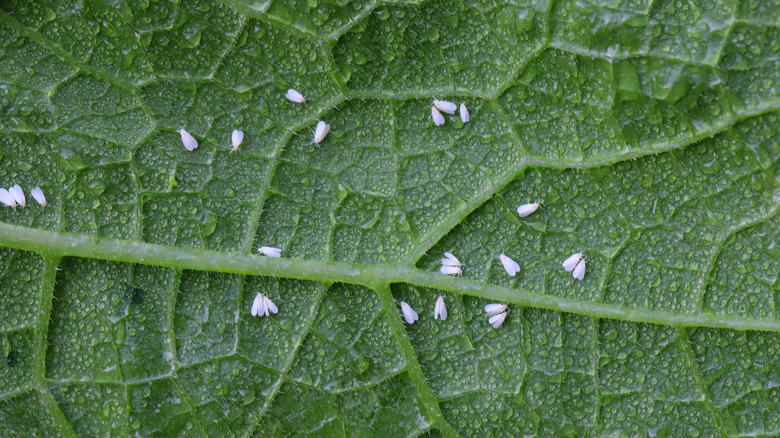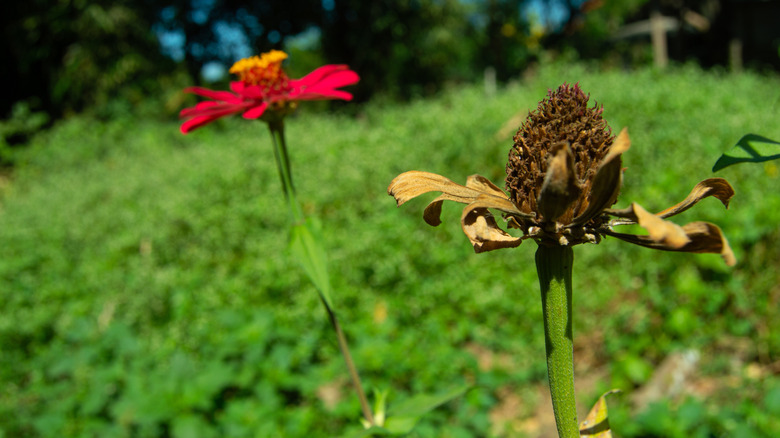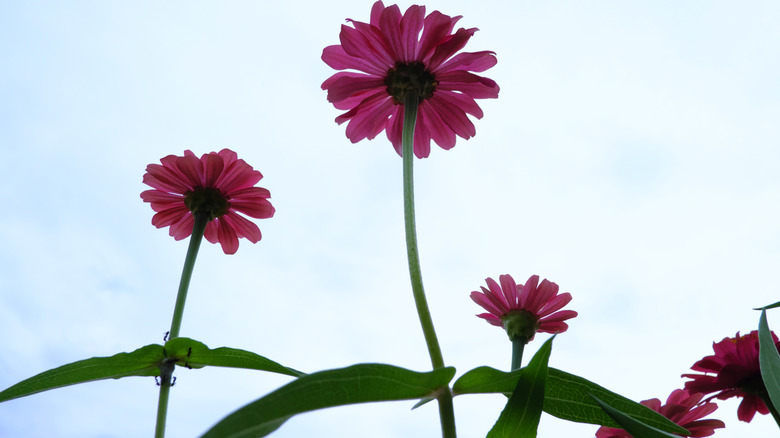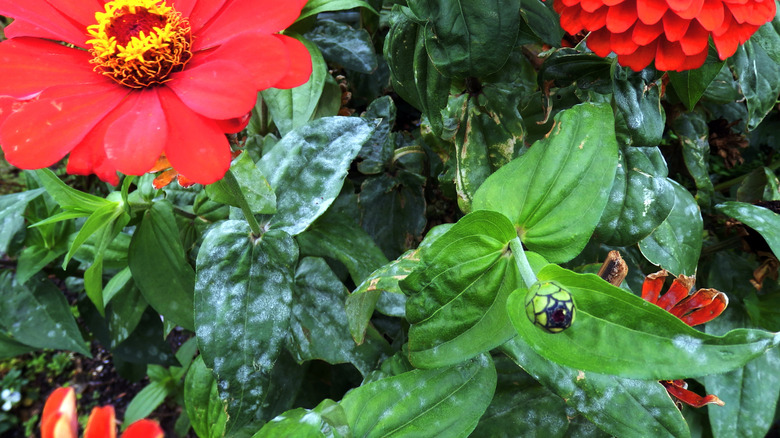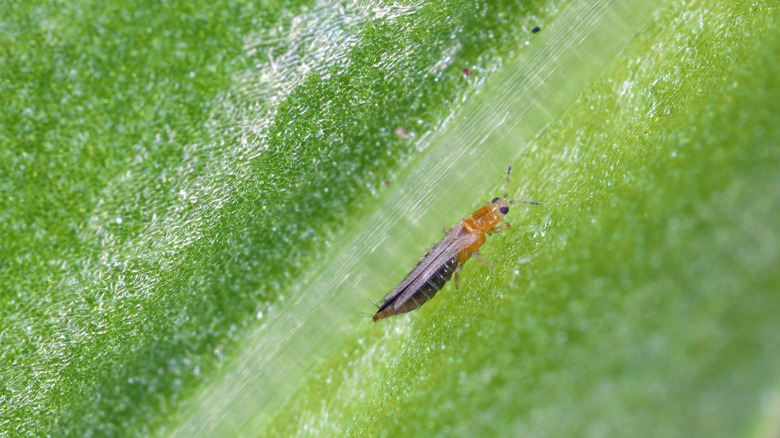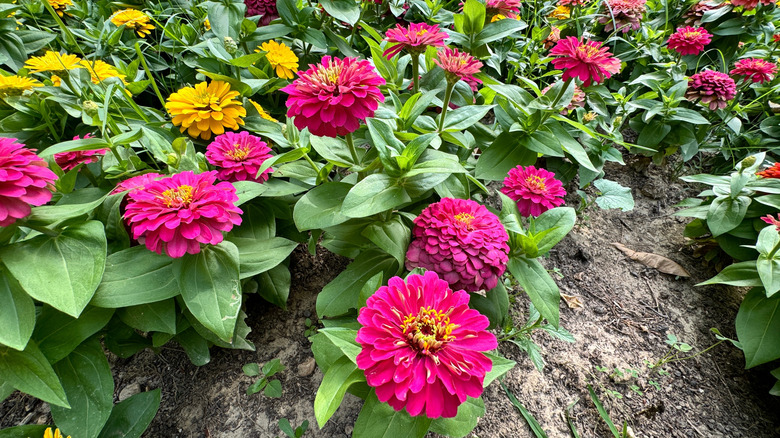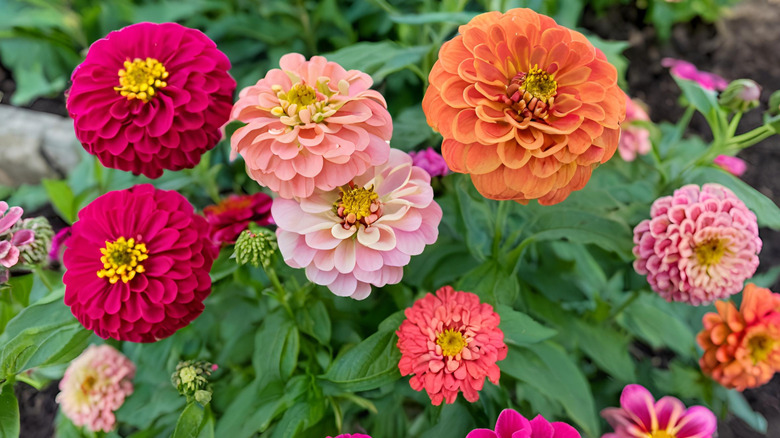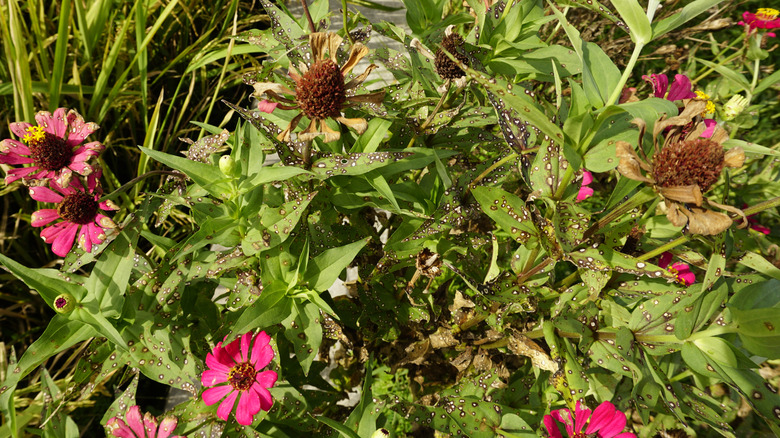Common Zinnia Problems You Shouldn't Ignore
We may receive a commission on purchases made from links.
Zinnias, with their vibrant blooms and cheerful disposition, are a garden favorite for a reason. However, even these seemingly easygoing flowers are susceptible to a range of problems that can quickly turn a flourishing display into a garden full of heartache and frustration. From fungal diseases that destroy their leaves to pests that devour their petals, ignoring these zinnia problems would be a mistake that can cause a rapid decline in your plant's health and beauty.
That's why we're breaking down some of the most common issues gardeners have while growing them. We'll dive into what the problem is, the damage it can do, and how to correct or avoid the situation with a few easy steps. Learning about these common issues will help you get a strong handle on how to grow and care for zinnias and ensure a season of uninterrupted color.
Zinnia meltdown can turn your zinnia plants black and mushy
Even though zinnias are known for their resilience, they can suddenly succumb to "zinnia meltdown" once cut, which is a devastating and often unpredictable rapid decline that's linked to the fungus Fusarium commune. However, it still baffles florists and botanists. As florist Ellen Frost shared on the Seed Talk podcast, "I don't have a really good understanding of ... why it happens." Frost described the effects of the rapid destruction: "We'll get flowers into the shop and like, you know, in less than 24 hours they are completely black [with] smushed heads. You know, broken necks, black stems." This swift collapse can transform a vibrant display into a blackened, withered mess overnight.
While it's true that zinnia meltdown isn't fully understood, researchers believe there may now be a potential correlation between temperature and infection; a 2018 survey by the Association of Specialty Cut Flower Growers Research Foundation found that 58.7% of meltdown reports occurred during periods of high temperatures and humidity. While some things are a mystery with meltdown, we do know that prevention is crucial, especially since there's no guaranteed cure for zinnia meltdown yet.
To give your zinnias the best shot at avoiding or fighting meltdown, start with the layout and planting area you're designing, because proper air circulation is vital. The aforementioned survey found that 53.3% of respondents believed growing zinnias in enclosed spaces like greenhouses increased the likelihood of meltdowns. So, be sure to space plants at least 8 inches apart and avoid overcrowding. Also, refrain from overhead watering, as this fosters fungal growth, and ensure well-draining soil to prevent root rot, which weakens plants. If you think you're seeing signs of meltdown like wilted blooms and black stems right after harvesting for cut flowers, remove the affected plants to minimize spread as quickly as possible and double-check your plant spacing.
Whiteflies will feed on zinnias and weaken their cell structures
Whiteflies are incredibly tiny, winged insects that wreak havoc on zinnias by feeding on their sap. They're also prolific reproducers and the sheer number that can accumulate on a single plant is way more than you're probably thinking — never mind an entire zinnia patch. Whitefly infestations lead to yellowing leaves, stunted growth, and a sticky residue called "honeydew" coating the plant and flower, which attracts sooty mold and other fungal diseases. But beyond the direct damage they can do, whiteflies can also transmit plant viruses, further compromising your zinnia's health.
Getting rid of whiteflies isn't easy once they've set up shop and requires a multi-pronged approach. First, regularly inspect the undersides of leaves for signs of infestation. For mild infestations, a strong jet of water from the hose can dislodge the insects, but introducing natural predators like ladybugs or lacewings can help, too. To be extra sure, try wiping the plant down with insecticidal soap or neem oil. If you're dealing with a severe infestation, you can try a stronger insecticide, but always prioritize the least toxic option to keep your garden's ecosystem safe for pollinators and other beneficial insects. Finally, remember to keep up with your plant chores, such as removing weeds and debris, which can hide whiteflies.
Soft rot turns zinnias into mushy, brown messes faster than you'd think is possible
Soft rot or bacterial blight is a destructive disease that turns zinnia stems and flowers into soft, mushy messes. Soft rot is incredibly good at what it does and will spread quickly, particularly in warm, humid conditions. It's caused by bacteria that thrive in moist environments entering the plant through wounds or natural openings. Infected areas become oversaturated with water, then quickly break down, emitting a foul odor as they decay. Soft rot can affect any part of the zinnia, from stems to flower heads, leading to complete plant collapse.
Like meltdown, preventing bacterial blight is crucial, as there's no reliable cure once it takes hold. Always remove infected plant materials to prevent the spread of bacteria. Avoid overhead watering and ensure proper spacing between plants to promote air circulation, which helps reduce humidity. If you suspect an outbreak of soft rot, immediately remove and destroy the affected plant to prevent further contamination in the garden. Avoid working with wet plants, as this can spread the bacteria. In severe cases, copper-based fungicides may offer some relief for your zinnias, but prevention is always the best approach.
Flopping stems can lead to breakage or deformed zinnias
Flopping stems (technically known as lodging) is a common issue where zinnia stems bend or break, causing the plant to collapse. Lodging not only disrupts the plant's aesthetic appeal, but can also hinder flower production, as the stems are too weak to hold the flowers up to get sunlight. While the biggest culprit for lodging is heavy rain or strong winds, lack of sunlight and over-fertilization, particularly with nitrogen, can also contribute to weak, leggy growth that makes stems prone to flopping.
Stopping stems from flopping can be done in a few ways and is one of the easier things to fix on this list. First, provide adequate support, especially for tall or large-flowered varieties, using stakes, cages, or trellises. Shorter varieties also need support — but one layer of some hortonova trellising (such as this Tenax Hortonova White Net) should be enough. Next, ensure your zinnias receive at least six hours of direct sun to promote strong stem development. Avoid over-fertilizing, especially with nitrogen-rich fertilizers, to ensure you don't get lush but weak growth, and water at the base of the plant to avoid soaking the stems, which can also weaken them. If flopping occurs, gently lift the plant and provide support, but avoid trying to force stems upright if they are severely bent or broken.
Powdery mildew can make new growth wonky and cause premature leaf drop
Zinnias are highly susceptible to powdery mildew, a rapidly spreading fungal disease that coats leaves and stems with a white, powdery substance. Once infected, leaves will drop off quickly, which may sound like a good thing, but zinnias need their leaves for photosynthesis and losing them too fast can weaken the plant. New leaves and buds can also be affected, ending up smaller or distorted.
Preventing powdery mildew from taking over is key to maintaining healthy zinnias. Start by regularly inspecting plants for early signs of powdery mildew and promptly remove affected leaves or plants to prevent further spread. This disease thrives in high-humidity environments, particularly where day and night temperatures fluctuate significantly. Provide ample spacing between plants to ensure good air circulation, which will go a long way toward reducing localized humidity. If you live in an area that's super humid, you can also look into zinnia hybrids that have been bred to have some level of resistance to powdery mildew, such as the 'Profusion' series.
Most sources recommend watering at the base of the plant to keep foliage dry whenever you're dealing with fungal issues, as overhead watering can create favorable conditions for fungal growth. However, water sprays are actually one way you can rinse this pesky mold off of your zinnia plants, and the spores die when they come into contact with water. If you try this technique, spray with water in the morning on a sunny day so the leaves have a chance to dry off. Fungicides can be used as a preventative measure or to control mild infections, but prioritize less toxic options to keep your garden pollinator-friendly. Finally, keep up with your garden chores, like removing fallen leaves or debris, because maintaining good garden hygiene can also help reduce the risk of infection.
Thrips will suck out zinnia sap and weaken the plant
Thrips are minute bugs that feed on zinnia flowers and leaves, causing significant damage. Like whiteflies, thrips are really good at reproducing and are difficult to detect on all of that zinnia foliage due to their small size. They use their rasping mouthparts to puncture plant tissue and suck out the fluids. Some of the tell-tale signs your plants have thrips include distorted zinnia flowers, silvery streaks on leaves, and stunted growth. If the infestation gets really bad, your zinnia flowers may end up discolored, deformed, or fail to open at all. Thrips can also transmit plant viruses, further compromising zinnia health.
Controlling thrips requires constant vigilance, so regularly inspect zinnias for signs of thrips, paying close attention to flower buds and young leaves. If you suspect a colony has broken out, introduce natural predators like lacewings or predatory mites, which feed on thrips. For mild infestations, try hitting them with a strong jet of water to dislodge their hold on your flowers. Insecticidal soap or neem oil can be effective, but apply them in the early morning or late evening to ensure the pollinators that grace your garden aren't affected. Also, remove and destroy heavily infested flowers and leaves to prevent further spread, and pull weeds or debris that might be hiding thrip larvae.
Double-bloom types can revert to single blooms and are nearly impossible to control
Double-bloom zinnias are prized for their full, layered petals, but can sometimes revert to producing single blooms. This reversion is not a disease or pest issue, but rather a genetic instability inherent in some double-flowered varieties that can occur spontaneously — and there's no way to predict which plants will revert. Environmental factors, such as stress from extreme temperatures or poor growing conditions, may exacerbate the tendency, but the underlying cause is primarily genetic.
Unfortunately, there's no way to reliably prevent or rewind the genetic reversion of double blooms to single blooms. If you notice a zinnia producing single blooms, you can try removing those flowers to potentially encourage the plant to try again and produce more double blooms, but this may not always be effective. If you prefer exclusively planting double blooming zinnias, your best bet is to start by using reputable seed sources that have a historically lower tendency for producing zinnias that revert. When saving seeds, you can try only collecting from plants that consistently produce double flowers. For reliable true-to-type results and less risk of reversion, consider purchasing new seeds or plants each season to improve your chances. But don't forget that, while the reversion can be disappointing, single blooming zinnias are still gorgeous flowers and having a mix of bloom types can add a little variety to your garden.
Overcrowding becomes a massive issue for zinnias that lets fungal diseases spread
Overcrowding occurs when zinnias are planted too closely together, leading to a host of problems. The primary issue with overcrowding zinnias is from the competition it creates for essential resources like sunlight, water, and nutrients. Plants become stressed, resulting in weak, leggy growth, reduced flowering, and increased susceptibility to diseases and pests. Also, as we've mentioned before, poor air circulation caused by overcrowding creates a humid environment that encourages fungal diseases like powdery mildew to develop. Overcrowded zinnias also make it difficult to spot and address pest infestations or disease outbreaks early on.
We know we keep saying it, but preventing overcrowding really is essential for healthy zinnias. When planting, consider the mature size of the zinnia variety and follow the recommended spacing guidelines on seed packets or plant tags — typically 8 to 18 inches apart — depending on the variety. Thin out seedlings or young plants to ensure adequate spacing. Prune or deadhead plants regularly to improve air circulation and prevent excessive foliage growth. If you notice signs of stress or disease, immediately address the issue and consider transplanting some plants to provide more space. Maintaining good garden hygiene by removing weeds and debris can also help prevent overcrowding-related problems.
Alternaria leaf spot causes premature leaf drop and weakens zinnias
Alternaria leaf spot is a fungal disease that creates dark, circular rust-like spots on zinnia leaves and stems, weakening them and reducing their aesthetic appeal. This disease thrives in warm, humid conditions, particularly when plants are stressed or weakened. The spots start small and brown, then expand, often developing a target-like pattern with concentric rings. Severely infected leaves may wither, and drop, leading to significant leaf loss.
The easiest way to prevent Alternaria leaf spot is with starting off with fungal-resistant varieties. Zinnia angustifolia, marylandica hybrids like those in the 'Zahara' series, and the 'Profusion' series are known for their strong resistance to fungal infections and other common zinnia diseases. Provide adequate spacing between plants to ensure good air circulation, which helps reduce humidity. Water at the base of the plant to keep foliage dry, as overhead watering can create favorable conditions for fungal growth. Remove and destroy infected leaves or plants promptly to prevent further spread. Strong, healthy plants are less susceptible to disease, so ensure they receive adequate sunlight, water, and nutrients. If you want to try and kill off the fungus, copper-based fungicides are recommended.
Planting too deep can lead to stem rot and impact germination
Planting zinnias too deep, whether from seed or from flats, can be fatal. While you might think planting them deep can anchor the zinnias better, in transplants, the stem may rot which could be the death of your young plants. This is even more likely for zinnias planted in heavy, poor-draining soils, where waterlogging can exacerbate the problem. Sowing direct? Zinnia seeds need light to germinate, so if you place them too deep in the soil, they may fail to emerge.
For transplants, Plant zinnias at the same depth they were growing in their original containers. Ensure the planting hole is wide enough to accommodate the root ball and that the soil is loose and well-drained. When planting seedlings, gently loosen the roots to encourage them to spread outward. After planting, water thoroughly to settle the soil, but avoid overwatering, which can lead to root rot. Mulch around the base of the plants to help retain moisture and regulate soil temperature, but keep the mulch away from the stems to prevent rot. For direct sowing, check the depth recommended on seed packets, usually around ¼ of an inch. If you don't want to push each seed into the ground, you can try raking them in by running a rake over the area, spreading your seeds, and then lightly raking in the opposite direction to cover them with soil.
